The Adena Giant Revealed:
Profile of Prehistoric Mound Builders
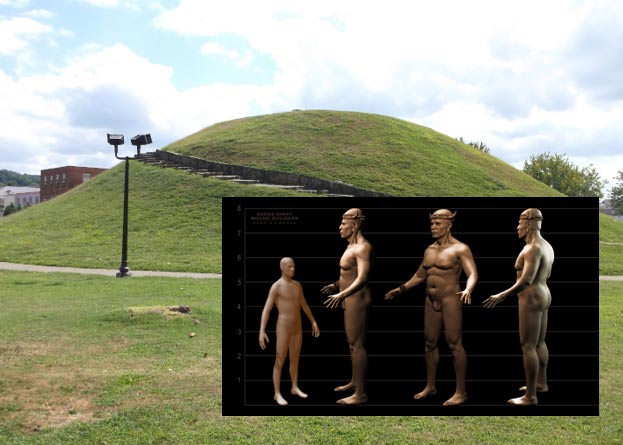
In the 1800s, reports began to surface of the discovery of very large skeletal remains in the burial mounds of North America. These skeletons were described as reaching seven to eight feet (2.4 meters) in length, with a lower frequency of discoveries spanning nine to 11 feet (3.3 meters) in length, and having very large skulls and gigantic lower jawbones.
Historians often detailed these remains in early local historical records, such as the following from Cass County, Michigan:
“It was a mound about thirteen feet high…. the diameter of its base was about fifty feet…Portions of the skeletons were in a good state of preservation. The femur, or thigh bone, of one of the males, which Dr Bonine has now in his possession, is of great size and indicates that its owner must have been at least seven feet in height”
-
Alfred
Matthews, History of Cass
County, Michigan 1882
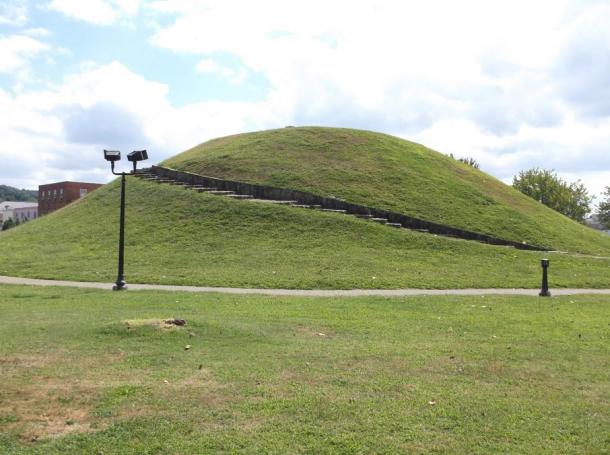
The Criel Mound in South Charleston West
Virginia, photo courtesy of authors © Jason Jarrell and Sarah Farmer. The
35-foot (11 m) high and 175-foot (53 m)-diameter conical mound, is
the second largest of its type in West Virginia.
Accounts of Exceptional Burial Mounds
“A recent exploration of a mound near this place resulted in some interesting discoveries…The form was large, the jaws massive, and the teeth perfect.”
As is well known, 19th and early 20th century newspapers frequently ran stories of gigantic skeletons found throughout the country. The following report from Portsmouth, Ohio was run by the News Herald on January 3, 1895:
“Bridge Carpenters on the N. & W. R. R. found a gigantic skeleton while excavating, three miles east of Portsmouth, a few days ago. The skeleton measured, 7 feet, 4 inches…”
In the 1880s, the Eastern Mound Division of the Smithsonian discovered a number of gigantic skeletons in their wanton destruction of North American tumuli. The 12th Annual Report of the Bureau of Ethnology documents numerous gigantic skeletons found by Smithsonian agents:
“Near the original surface (of the mound)… lying at full length upon its back, was one of the largest skeletons discovered by the Bureau agents, the length as proved by actual measurement being between 7 and 8 feet.”
“In the center (of mound 11), 3 feet below the surface, was a vault 8 feet long and 3 feet wide. In the bottom of this…lay a skeleton fully 7 feet long…”
“The length from the base of the skull to the bones of the toes was found to be 7 feet 3 inches. It is probable, therefore, that this individual when living was 7.5 feet high.”
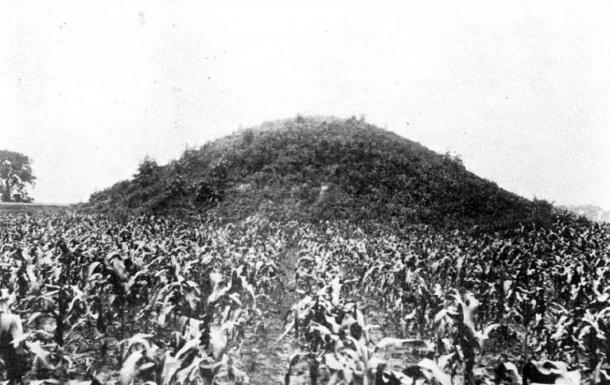
Pre-excavation view of the Adena Mound,
located in Chillicothe, Ohio, United States, northwest of downtown. The type
site for the Adena culture, the site is listed on the National Register of
Historic Places, even though the mound was removed decades ago. It was
excavated in 1901. (Public Domain)
Extraordinary Skeletal Features
“The forehead is typically a prominent one, bordered below by fairly prominent brow ridges….The characteristic bulge of the upper and lower jaws (alveolar prognathism) is moderate in projection…Usually the cheek bones are not only of large size in themselves but they have a forward and lateral prominence…” (Webb Snow and Baby, 1957)
In addition to these strong features, Webb Snow and Baby (1957) remarked upon the “great width of the bony chin, formed by bilateral eminences”.
The typical Adena crania were extremely high vaulted (brachycephalic):
“Approximately 89% of the adult males, 92% of the adult females are brachycephalic.” (Webb and Snow 1945)
In their report on the Dover mound in Kentucky, Webb and Snow noted that the Adena crania to represent the “highest skull vaults reported anywhere in the world” (Webb and Snow, The Dover Mound. 1959) Cephalic indices measured for Adena range from 89 to 100. (Webb, Snow and Baby 1957)
The Adena People practiced artificial flattening of the occipital region, which added height to the cranial vault. This practice merely enhanced congenital features:
“…those skulls with slight or no deformation (undeformed) present similar proportions”.(Webb and Snow, 1945)
“It is likely that many, if not most, of the skull characteristics so typical of Adena are of genetic nature…” (Webb, Snow and Baby 1957)
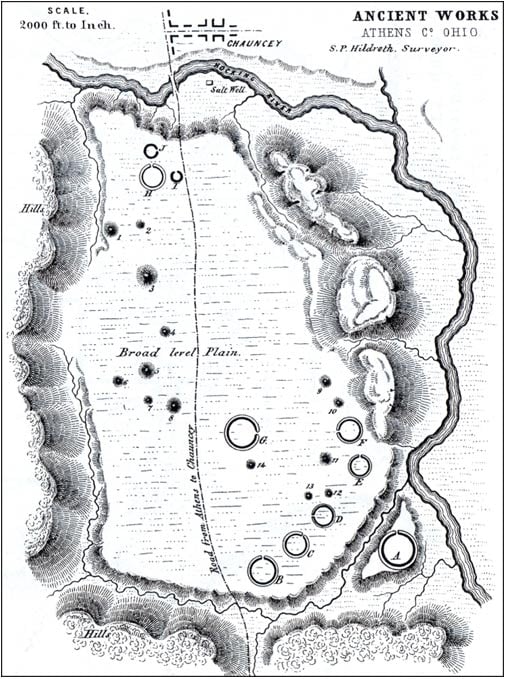
The “Wolf Plains Group”, aA Late Adena group
of 30 earthworks including 22 conical mounds and nine circular enclosures.
Located a few miles to the northwest of Athens, Ohio, USA. (Public
Domain)
Beings “of Large Proportions”
“…the remains of burial 40 is one of the largest known to Adena; the skull-foot field measurement is 84 inches (7 feet).” ( Webb and Snow, 1959)
In1958, Don Dragoo of the Carnegie Museum uncovered the remains of an individual “of large proportions” in a subsurface tomb at the lowest strata of the Cresap Mound in West Virginia. Burial 54 as described by Dragoo in Mounds for the Dead (1963):
“When measured in the tomb his length was approximately 7.04 feet. All the long bones were heavy and possessed marked eminences for the attachment of muscles.”
Dragoo described the unique traits of Adena, including the “protruding and massive chin” with “prominent bilateral protrusions”, as well as “individuals approaching seven feet in height”. (Dragoo, 1963)
It is important to note that in considering this information from Webb, Snow, and Dragoo, regularly occurring gigantic members are not the only unique features of the Adena People:
“Not only were these Adena People tall but
also the massiveness of the bones indicates powerfully built individuals. The
head was generally big with a large cranial capacity.”
-
(Dragoo,
1963)
Setting the Standard for Giantology
And yet, in spite of this tradition of rediscovery, no satisfactory reconstruction of an Adena giant has ever been undertaken. While we are routinely reminded of the dimensions of the giants in volumes reprinting multiple hundreds of accounts of their discovery, we have been denied imagery representing their living form. While numerous other anomalies (such as the Paracas and “Starchild” crania) have received due attention, the gigantic Adena have remained shrouded in mystery. In May of 2015, the authors undertook a joint venture with the legendary Marcia K Moore to remedy this situation.
Artist Fills in Gaps in Hidden History
The skull used for the Adena recreation was that of burial 16 from the Wright Mounds in Kentucky, photographed in figure 25 of The Adena People No1, where it is described as showing “pronounced” deformation. In Skeletal Material from the Wright Site, Montgomery County, Kentucky (1940) H.T.E. Hertzberg noted that the crania of the Wright site featured the large, prognathic lower mandibles (or protruding lower jaw) typical of Adena, and although artificially deformed, the series demonstrated the large congenital features detailed by Webb, Snow and Dragoo:
“…deformed as they are, these crania display a pronounced brachycrany…it may be noticed that four skulls…displaying submedium deformation, also give an average cranial index of over 90%. Thus the inference is that these people would have shown pronounced brachycrany even without deformation…”
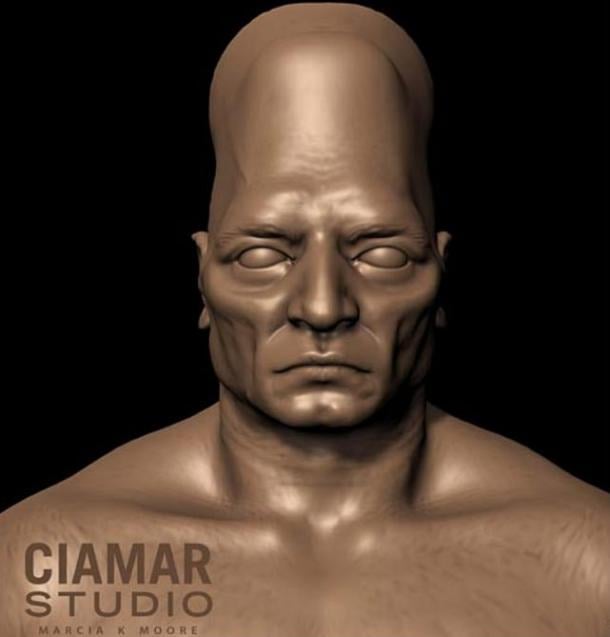
Artist’s representation of North American
giant. Credit: Marcia K Moore / Ciamar Studio. Visit http://www.marciakmoore.com/giants.html
Within this structure was a “gigantic and prominent personage, surrounded by 5 of his (probably volunteer) warriors…” Norris measured the central burial in situ and described it as “a gigantic human skeleton 7 feet 6 inches in length and 19 inches between the shoulders…”
Elsewhere in the manuscript, this skeleton is regularly referred to as “the giant” or “gigantic". Significantly, this particular burial was wrapped in bark and covered with a dry clay. This certainly suggests that the in-situ measurements would have been accurate, rather than the product of some type of disarticulation due to the weight of the mound mass, as mainstream sources often claim.
The measurements provided by Norris are similar to those from several other sources, including this account of a gigantic specimen unearthed by Warren K Moorehead in Ohio, documented in his Primitive Man in Ohio (1892):
“Six feet above these remains was found the partial skeleton of a man almost a giant in size….The breadth across the shoulders, with the bones correctly placed, was nineteen inches…”
The anthropological details of Adena recorded by Webb, Snow and Dragoo and the early historians and antiquarians corroborate Norris’ account and indicate individuals approaching eight feet (2.4 meters) tall. Since a high frequency of reports describe skeletons reaching this height, the data was used by Marcia to formulate the likely dimensions and appearance of an eight-foot-tall Adena in the flesh.
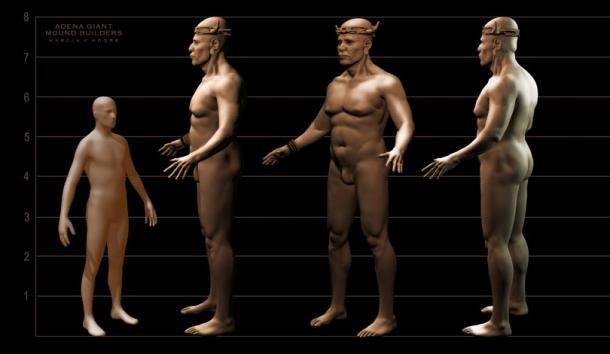
Artist’s representation of the “Adena Giant”,
Prehistoric Mound Builders. Credit: Marcia K Moore / Ciamar Studio. Visit www.marciakmoore.com
Missing History Comes to Life
Marcia is currently working with the authors on a book to be published in 2016 that will feature an extensive set of her recreations of Adena and Adena-like individuals from the burial mounds of North America and around the world. This important visual work will accompany the presentation of 7000 years of obfuscated world history.
Featured image: Main: The Criel Mound in South Charleston West Virginia, photo courtesy of authors © Jason Jarrell and Sarah Farmer. The 35-foot (11 m) high and 175-foot (53 m)-diameter conical mound, is the second largest of its type in West Virginia. Inset: Artist’s representation of the “Adena Giant”, Prehistoric Mound Builders. Credit: Marcia K Moore / Ciamar Studio. Visit www.marciakmoore.com
The Adena People and Prehistoric Colonization of North America
European scholars have noted evidence of ancient colonization of North America. After studying American Mounds and Earthworks, Dr C.A. Adolph Zestermann (Leipzig) wrote in 1851:
“I can find no other explanation other than a gradual migration of a portion of the human family from one part of the world to another-from one hemisphere to the other. In short, I see in it a colonization of America, by means of an immigration from Europe.”16
Unique cranial features of Adena people
shared with European Beaker people
“Approximately 89% (31 of 35) of the adult males, 92 % (22 of 24) of the adult females are brachycephalic.”1
“The forehead is typically a prominent one, bordered below by fairly sizeable brow ridges. The root of the nose is of average proportions and continues on to a prominent convex bridge that is one of the prominent features of the face. The characteristic bulge of the upper and lower jaws (alveolar prognathism) is moderate in projection…Usually the cheek bones are not only of large size in themselves but they have a forward and lateral prominence…”2
Snow felt that these traits, along with the “great width of the bony chin” distinguished Adena from their predecessors and contemporaries.2
The Adena practiced artificial deformation of the occipital region, enhancing their large congenital features. Webb and Snow noted that Adena skulls were “the highest known in the world”2 with an average index of 89.5, while the deformed skulls reached as high as 100a2.
The characteristics of the Beaker People are virtually identical to Adena. Carlton Stephen Coons:
“Where Bell Beaker burials are found in central Europe, the skeletons are almost always of the same tall brachycephalic type…”
“…the browridges are often heavy, the general ruggedness frequently greater. The faces are characteristically narrow, the orbits medium to high, the nasal skeleton high and aquiline; the occiput frequently flat.”
“They form one of the rare groups in the world with a cranial length of 184mm and an index of over 80.”3
William Boyd Dawkins described the beakers’ brachycephalic crania as having “strongly marked” ridges, “high and broad” cheek bones, and jaws “presenting prognathism”,4 while Burkett described “large teeth” in the “powerful” lower jaw.5
The Beaker People practiced the same type of occipital cranial deformation as Adena:
“…there is also generally an occipital flattening which may have been caused by the use of an unyielding cradle board...”4
“One usual normal form of these crania is brachycephalic, and that decidedly so…and it is too obvious to need remark, that the mode of nursing would heighten this brachycephalism.”6
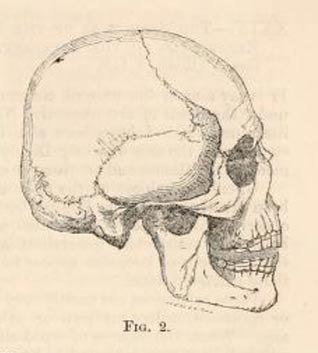
Brachycephalic Beaker skull from the Natural
History Review, 1862. Courtesy Archive.org.
Giant skeletons
A truly gigantic specimen has been documented from Castelnau-le-Lez, Southern France. In 1890, while excavating the Neolithic strata of a burial mound, Georges de Lapouge discovered the humerus, tibia, and femoral shaft of an individual he estimated to be between 11 and 12 feet tall. Lapauge’s conclusions were officially published in La Nature, Vol 18 (888) along with an image of the bones with a normal size humerous.7
“I think it unnecessary to note that these bones are undeniably human, despite their enormous size…The subject would have been a likely size of 3m, 50.”
Significantly, these remains were studied by several of Lapouge’s contemporaries, who agreed that these were indeed the bones of a giant human, as reported in The August, 1890 issue of Popular Science.8
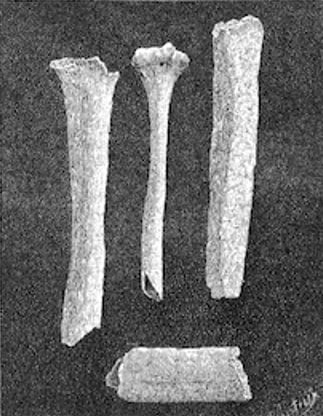
Bones of the Giant of Castelnau in La Nature,
1890. Courtesy of Wikipedia.org
In 1918, at Surrey, England, the “giant” skeleton of a man of “unusual stature” was found in a “perfect state of preservation”.9 At the Woodyates barrow group in Wiltshire, Richard Colt Hoare unearthed a “large skeleton” and another of a “tall and stout man”.10 In 1833, a “skeleton laid at full length within a rude cist”, was discovered at Port Seaton, Scotland. Measurements “indicated the remains of a man nearly seven feet high.”11
The discovery of gigantic skeletons in several caves around the U.S. has been a popular subject in recent years. Less known are the documented finds on record from the dark zone in Europe.
In the late 1800s, a series of unusual remains were found at the Mentone Caves on the coast of Italy. The skeletons were the subject of an article in the November, 1895 issue of popular Science. According to the article, in 1884 a male skeleton “of gigantic size, being six feet and nine and a half inches in height…” was found. In 1892 three more skeletons were found, two of which measured “6 feet 6 inches and a half”, while the third was “ six feet ten inches and a half” estimated to stand “about seven feet four inches” while living. The crania are described as being “of unusual size and thickness”, with “unusually large” orbital cavities, and “large teeth”, the “front nearly as large as molars”. Skeletons were interred on their sides in “a cist or rude dolmen”, and were covered in red ocher. Artifacts include flint blades, shells, and deer teeth.12 Neolithic Axes have also been found.13
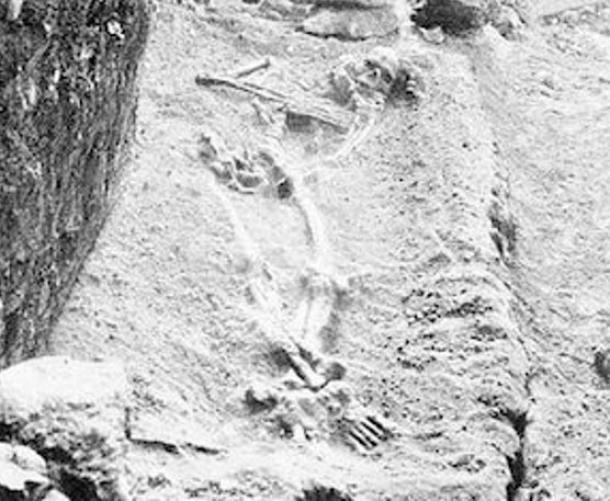
A “gigantic” skeleton in situ from the
Mentone caves. Popular Science 48, 1895. Courtesy of Wikisource.org
Dating the Beaker and Adena cultures
The Unetice Culture is divided into “Older” and “Younger” phases. The earlier phase lasts from about 2200 B.C. to 2000 B.C., while the “younger” phase commences and lasts until 1800-1700 B.C., when descendents formulate the Tumulus and Trzciniec Cultures.
The Tumulus Culture phase lasts from roughly 1700-1200 B.C. before being succeeded in the Early Iron Age by the Urnfield (1300B.C.), Hallstatt, (800-500B.C.), and La Tene Cultures, identified as the “Keltoi” of ancient history.
Historically, the cultural “genealogy” of the Beaker legacy (including tumulus and earthwork construction) continues in one form or another for over 2,000 years after the initial appearance in the Chalcolithic/EBA. At the same time, a review of radiocarbon dates pushes Adena further into the past.
A Radiocarbon date of 1200-1100 B.C. was attained from the lower level of the Toepfner Mound in Ohio.14 Also from Ohio, The Kline (822 B.C.), Arthur James (803+/-115 B.C.), Munson Springs (833 and 764 B.C.), and William H Davis (1405+/-60 BC)15 mounds have all yielded very early dates. A date of 1635 B.C. was attained from the lower level of the Cresap Mound in West Virginia, which Don Dragoo determined to be too early for Adena.14 The Dover Mound in Kentucky produced a date of around 780 B.C from an upper tomb in the structure.16
Two Red Ocher tumuli at the Morton Mound group in Illinois have been dated to 1200 B.C.17 Artifacts of the Red Ocher Culture are noted as mixed with those of Adena at several mounds at the Turkey River Ring in Iowa,18 a circular ditched enclosure. Two mounds inside of the enclosure yielded dates of 600(mound 38) and 800 B.C. (Mound 39).19
In addition to obvious cultural and artifact similarities, Red Ocher is considered to be ancestral to Adena due to the brachycephalic crania found in Red Ocher graves.14
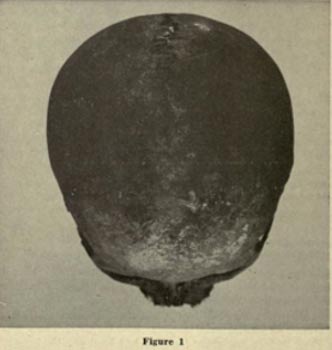
A brachycephalic Red Ocher skull, Wisconsin
Archaeologist. Coutesy of Archive.org
This site was believed by Ritchie,20 Webb,2 and Dragoo14 to represent the “prototype” of the Cult of the Dead of the Glacial Kame, Red Ocher, Adena, and Hopewell cultures. At the Berryhill site in Ohio (1300 B.C.), brachycephalic crania featuring occipital deformation were determined to belong to a group “ancestral” to
Adena.21 Graves also featured red ocher.
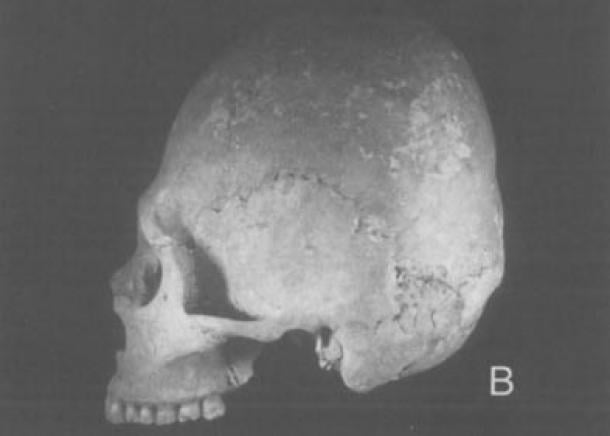
Adena like crania from the Berryhill
Cemetery, Ohio. From Pennsylvania Archaeologist, Vol 74
In West Virginia, Early Adena Fayette-Thick and Half-Moon Pottery has been found in contexts dating to 1375 and 1290 B.C.,23 and in Ohio to 1500 B.C..24 Adena Pottery is derived from the Vinette 1 pottery, which some have actually ascribed to a Western European origin.25
Thus, just as the legacy of the Zoned Beaker cultural package reaches across the span of 2000B.C. to the dawn of the first millennia A.D., Adena-type mounds and earthworks, artifact types, and cultural traits extend back into the second and possibly even the third millennium B.C. Here the source was in all likelihood associated with the Old Copper Complex. Old Copper Artifacts are strikingly similar to Bell Beaker types.
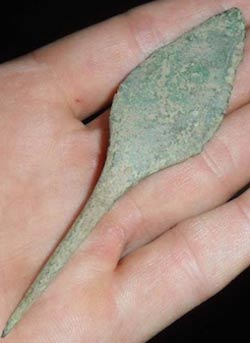
Bell beaker Palmela point, courtesy of
bellbeakerbloggerblogspot.com
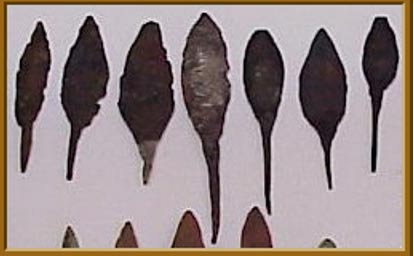
North American Old Copper “rattail” points,
courtesy of copperculture.homestead.com
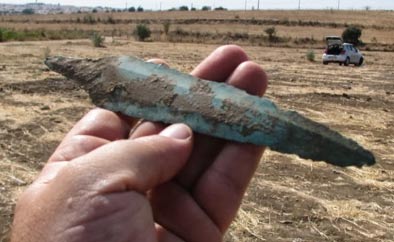
Bell Beaker Dagger, courtesy of
perdresearch.com

Beaker dagger from Crania Britannica,
courtesy of Hathitrust digital library
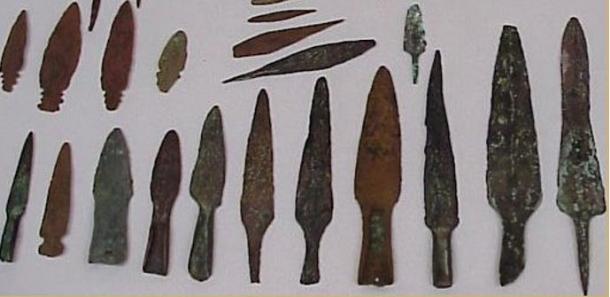
North American Old Copper tanged points,
courtesy of copperculture.homestead.com
Today, diffusionism is still considered “cult” archaeology. Yet the possibility persists that an ancient culture did indeed cross the Atlantic millennia ago.
2.
Webb,
Snow and Baby, The Adena People Number 2
3.
C.S.
Coons, The Races of Europe https://archive.org/stream/racesofeurope031695mbp#page/n3/mode/2up
4.
William
Boyd Dawkins, Cave Hunting http://babel.hathitrust.org/cgi/pt?id=mdp.39015030526290;view=2up;seq=174
5.
M.C.
Burkett, Our Early Ancestors. (1929)
6.
Joseph
Barnard Davis, The Natural History Review, 1862 https://archive.org/stream/naturalhistoryre1862belf#page/290/mode/2up
7.
La
Nature, Vol 18, 888 http://cnum.cnam.fr/CGI/fpage.cgi?4KY28.35/15/70/536/0/0
Special
recognition to rephaim23 for rediscovering the French Giants.
8.
Popular Science, August 1890
9.
The Owosso Times, 1/25/1918
10.
Richard
Colt Hoare, The Ancient History of Wiltshire, Vol 1
11.
Daniel
Wilson, The Archaeology and Prehistoric Annals of Scotland, 1895
12.
Popular Science, November 1895
13.
Boyd
Dawkins, The Present Phase of Prehistoric Archaeology
14.
Don
Dragoo, Mounds for the Dead
15.
Transitions:
Archaic and Early Woodland Research in the Ohio Country, edited by Otto and
Redmond
16.
Webb
and Snow, The Dover Mound
17.
Michael
Strezewski, Mississippian Period Mortuary Practices in the Central Illinois
River Valley
18.
Whitaker
and Green, Early
and Middle Woodland Earthwork Enclosures in Iowa
19.
Lynn
M. Alex, Iowa’s
Archaeological Past
20.
William
Ritchie, Recent Discoveries Suggesting an Early Woodland Burial Cult in the
Northeast, 1955
21.
Paul
Sciulli and James M Heilman, Terminal Late Archaic Mortuary Practices at
Berryhill Cemetery
22.
Mike
Parker Pearson, Stonehenge-A New Understanding: Solving the Mysteries of the
Greatest Stone Age Monument
23.
See
Trader, in Woodland Period Systematics in the Middle Ohio Valley, edited by
Darlene Applegate and Robert C Mainfort.
24.
James
L Murphey, Archaeological History of the Hocking Valley.
- Alice Beck Kehoe, A Hypothesis on the Origin of Northeastern American Pottery.
From Ancient Origins
@ http://www.ancient-origins.net/unexplained-phenomena/adena-giant-revealed-profile-prehistoric-mound-builders-004876?nopaging=1
and http://www.ancient-origins.net/ancient-places-americas/adena-people-and-prehistoric-colonization-north-america-003342?nopaging=1
For more information about giants see http://nexusilluminati.blogspot.com/search/label/giants
For more information about elongated skulls see http://nexusilluminati.blogspot.com/search/label/elongated%20skulls
For more information about elongated skulls see http://nexusilluminati.blogspot.com/search/label/elongated%20skulls
- Scroll down
through ‘Older Posts’ at the end of each section
Hope you like this
not for profit site -
It takes hours of work every day by
a genuinely incapacitated invalid to maintain, write, edit, research,
illustrate and publish this website from a tiny cabin in a remote forest
Like what you see? Please give anything
you can -
Contribute any amount and receive at
least one New Illuminati eBook!
(You can use a card
securely if you don’t use Paypal)
Please click below -
Spare Bitcoin
change?
For further enlightening
information enter a word or phrase into the random synchronistic search box @
the top left of http://nexusilluminati.blogspot.com
And see
New Illuminati – http://nexusilluminati.blogspot.com
New Illuminati on Facebook - https://www.facebook.com/the.new.illuminati
New Illuminati Youtube Channel - https://www.youtube.com/user/newilluminati/playlists
New Illuminati’s OWN Youtube Videos
-
New Illuminati on Google+ @ For
New Illuminati posts - https://plus.google.com/u/0/+RamAyana0/posts
New Illuminati on Twitter @ www.twitter.com/new_illuminati
New Illuminations –Art(icles) by
R. Ayana @ http://newilluminations.blogspot.com
The Her(m)etic Hermit - http://hermetic.blog.com
DISGRUNTLED SITE ADMINS PLEASE NOTE –
We provide
a live link to your original material on your site (and links via social
networking services) - which raises your ranking on search engines and helps
spread your info further!
This site
is published under Creative Commons (Attribution) CopyRIGHT (unless an
individual article or other item is declared otherwise by the copyright
holder). Reproduction for non-profit use is permitted & encouraged - if you
give attribution to the work & author and include all links in the original
(along with this or a similar notice).
Feel free
to make non-commercial hard (printed) or software copies or mirror sites - you
never know how long something will stay glued to the web – but remember
attribution!
If you
like what you see, please send a donation (no amount is too small or too large)
or leave a comment – and thanks for reading this far…
Live long
and prosper! Together we can create the best of all possible worlds…
From the New Illuminati – http://nexusilluminati.blogspot.com
No comments:
Post a Comment
Add your perspective to the conscious collective